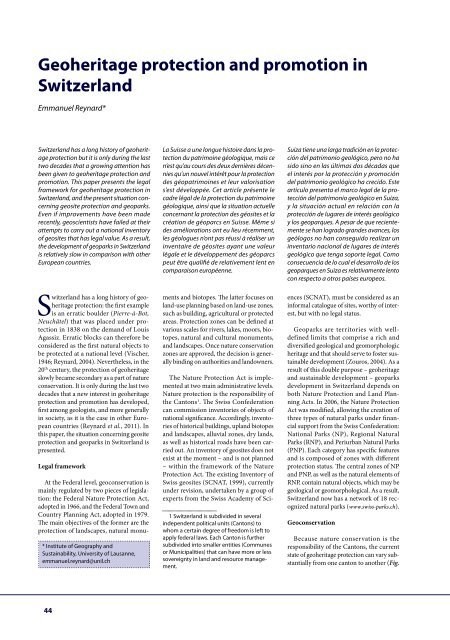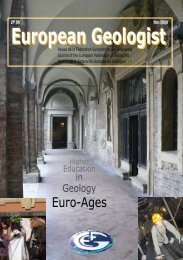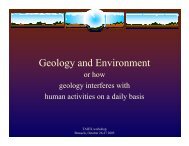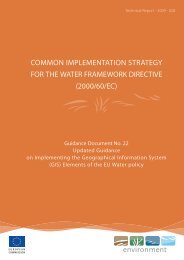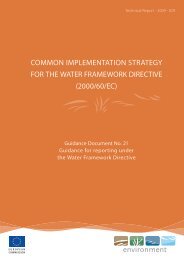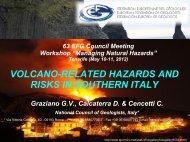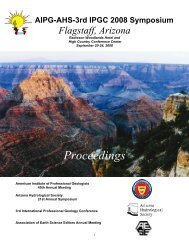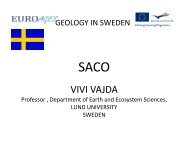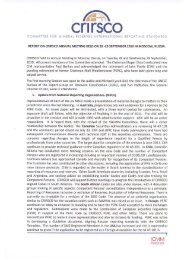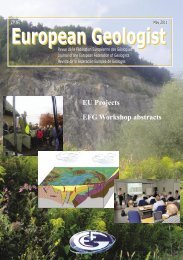European Geologist European Geologist Geoheritage - learning ...
European Geologist European Geologist Geoheritage - learning ...
European Geologist European Geologist Geoheritage - learning ...
Create successful ePaper yourself
Turn your PDF publications into a flip-book with our unique Google optimized e-Paper software.
<strong>Geoheritage</strong> protection and promotion in<br />
Switzerland<br />
Emmanuel Reynard*<br />
Switzerland has a long history of geoheritage<br />
protection but it is only during the last<br />
two decades that a growing attention has<br />
been given to geoheritage protection and<br />
promotion. This paper presents the legal<br />
framework for geoheritage protection in<br />
Switzerland, and the present situation concerning<br />
geosite protection and geoparks.<br />
Even if improvements have been made<br />
recently, geoscientists have failed at their<br />
attempts to carry out a national inventory<br />
of geosites that has legal value. As a result,<br />
the development of geoparks in Switzerland<br />
is relatively slow in comparison with other<br />
<strong>European</strong> countries.<br />
Switzerland has a long history of geoheritage<br />
protection: the first example<br />
is an erratic boulder (Pierre-à-Bot,<br />
Neuchâtel) that was placed under protection<br />
in 1838 on the demand of Louis<br />
Agassiz. Erratic blocks can therefore be<br />
considered as the first natural objects to<br />
be protected at a national level (Vischer,<br />
1946; Reynard, 2004). Nevertheless, in the<br />
20 th century, the protection of geoheritage<br />
slowly became secondary as a part of nature<br />
conservation. It is only during the last two<br />
decades that a new interest in geoheritage<br />
protection and promotion has developed,<br />
first among geologists, and more generally<br />
in society, as it is the case in other <strong>European</strong><br />
countries (Reynard et al., 2011). In<br />
this paper, the situation concerning geosite<br />
protection and geoparks in Switzerland is<br />
presented.<br />
Legal framework<br />
At the Federal level, geoconservation is<br />
mainly regulated by two pieces of legislation:<br />
the Federal Nature Protection Act,<br />
adopted in 1966, and the Federal Town and<br />
Country Planning Act, adopted in 1979.<br />
The main objectives of the former are the<br />
protection of landscapes, natural monu-<br />
* Institute of Geography and<br />
Sustainability, University of Lausanne,<br />
emmanuel.reynard@unil.ch<br />
La Suisse a une longue histoire dans la protection<br />
du patrimoine géologique, mais ce<br />
n’est qu’au cours des deux dernières décennies<br />
qu’un nouvel intérêt pour la protection<br />
des géopatrimoines et leur valorisation<br />
s’est développée. Cet article présente le<br />
cadre légal de la protection du patrimoine<br />
géologique, ainsi que la situation actuelle<br />
concernant la protection des géosites et la<br />
création de géoparcs en Suisse. Même si<br />
des améliorations ont eu lieu récemment,<br />
les géologues n’ont pas réussi à réaliser un<br />
inventaire de géosites ayant une valeur<br />
légale et le développement des géoparcs<br />
peut être qualifié de relativement lent en<br />
comparaison européenne.<br />
ments and biotopes. The latter focuses on<br />
land-use planning based on land-use zones,<br />
such as building, agricultural or protected<br />
areas. Protection zones can be defined at<br />
various scales for rivers, lakes, moors, biotopes,<br />
natural and cultural monuments,<br />
and landscapes. Once nature conservation<br />
zones are approved, the decision is generally<br />
binding on authorities and landowners.<br />
The Nature Protection Act is implemented<br />
at two main administrative levels.<br />
Nature protection is the responsibility of<br />
the Cantons 1 . The Swiss Confederation<br />
can commission inventories of objects of<br />
national significance. Accordingly, inventories<br />
of historical buildings, upland biotopes<br />
and landscapes, alluvial zones, dry lands,<br />
as well as historical roads have been carried<br />
out. An inventory of geosites does not<br />
exist at the moment – and is not planned<br />
– within the framework of the Nature<br />
Protection Act. The existing Inventory of<br />
Swiss geosites (SCNAT, 1999), currently<br />
under revision, undertaken by a group of<br />
experts from the Swiss Academy of Sci-<br />
1 Switzerland is subdivided in several<br />
independent political units (Cantons) to<br />
whom a certain degree of freedom is left to<br />
apply federal laws. Each Canton is further<br />
subdivided into smaller entities (Communes<br />
or Municipalities) that can have more or less<br />
sovereignty in land and resource management.<br />
Suiza tiene una larga tradición en la protección<br />
del patrimonio geológico, pero no ha<br />
sido sino en las últimas dos décadas que<br />
el interés por la protección y promoción<br />
del patrimonio geológico ha crecido. Este<br />
artículo presenta el marco legal de la protección<br />
del patrimonio geológico en Suiza,<br />
y la situación actual en relación con la<br />
protección de lugares de interés geológico<br />
y los geoparques. A pesar de que recientemente<br />
se han logrado grandes avances, los<br />
geólogos no han conseguido realizar un<br />
inventario nacional de lugares de interés<br />
geológico que tenga soporte legal. Como<br />
consecuencia de lo cual el desarrollo de los<br />
geoparques en Suiza es relativamente lento<br />
con respecto a otros países europeos.<br />
ences (SCNAT), must be considered as an<br />
informal catalogue of sites, worthy of interest,<br />
but with no legal status.<br />
Geoparks are territories with welldefined<br />
limits that comprise a rich and<br />
diversified geological and geomorphologic<br />
heritage and that should serve to foster sustainable<br />
development (Zouros, 2004). As a<br />
result of this double purpose – geoheritage<br />
and sustainable development – geoparks<br />
development in Switzerland depends on<br />
both Nature Protection and Land Planning<br />
Acts. In 2006, the Nature Protection<br />
Act was modified, allowing the creation of<br />
three types of natural parks under financial<br />
support from the Swiss Confederation:<br />
National Parks (NP), Regional Natural<br />
Parks (RNP), and Periurban Natural Parks<br />
(PNP). Each category has specific features<br />
and is composed of zones with different<br />
protection status. The central zones of NP<br />
and PNP, as well as the natural elements of<br />
RNP, contain natural objects, which may be<br />
geological or geomorphological. As a result,<br />
Switzerland now has a network of 18 recognized<br />
natural parks (www.swiss-parks.ch).<br />
Geoconservation<br />
Because nature conservation is the<br />
responsibility of the Cantons, the current<br />
state of geoheritage protection can vary substantially<br />
from one canton to another (Fig.<br />
44


